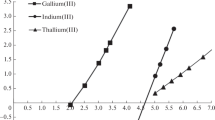Summary
A method was developed to determine micro-amounts of indium in zinc and in gallium by radioactivation analysis, using 1 g Ra-Be as thermalneutron source. By activation of an amount of 10 g metallic zinc during 5 hours and counting the activity in a well-type NaI-scintillation counter, 17.4 counts per sec. per 10 g Zn were obtained. This activity is practically entirely due to the 13.8 h.69Zn, the 52-mn isotope being a pureβ-emitter.
By activation of indium in the same conditions the116In, 54-mn isotope, gives a counting rate of 28.9 counts per second per 10 mg metal, so that it was possible to determine amounts of indium in zinc, using 10 g samples varying from 0.004% to 0.16% with a mean error of 2.3%, without chemical separation. To determine trace amounts of Indium in Gallium by activation at the same conditions as described above, it was necessary to carry out a chemical separation. 1 g metallic Ga gave indeed rise to an activity of 115 counts per second, mainly due to the 14.1-h.72Ga. The activation of the Ga-In samples was therefore carried out in an aqueous solution of their sulfates. After activation, potassium iodide and sulfuric acid were added as to obtain a 2 M solution of HI. The indium iodide was then extracted with diethyl ether and the ethereal solution introduced in a vial fitting the well-type crystal. Using 0.5-g Ga samples it was possible to determine indium amounts down to 0.2 mg, with a mean error of about 5%.
Zusammenfassung
Eine Methode zur Bestimmung kleiner Mengen Indium in Zink und in Gallium durch Aktivierungsanalyse wurde unter Verbindung von 1 g Ra-Be als thermische Neutronenquelle entwickelt. Nach Aktivierung von 10 g metallischem Zink durch 5 Stunden und Bestimmung der Aktivität in einem becherförmigen NaJ-Szintillationszähler wurden 17,4 Stöße pro Sekunde pro 10 g Zn beobachtet. Diese Aktivität kommt praktisch völlig dem69Zn von der Halbwertszeit 13,8 Stunden zu, da das Isotop mit der Halbwertszeit 52 Minuten ein reinerβ-Strahler ist.
Durch Aktivierung von Indium unter den gleichen Bedingungen gibt116In mit der Halbwertszeit 54 Minuten 28,9 Stöße pro Sekunde für 10 mg Metall, so daß es möglich war, unter Verwendung von 10 g Zink Indiummengen zwischen 0,004% und 0,16% mit einem mittleren Fehler von 2,3% ohne vorhergehende chemische Trennung darin zu bestimmen. Zur Bestimmung von Indiumspuren in Gallium durch Aktivierung unter den gleichen Bedingungen war es notwendig, eine chemische Trennungsmethode auszuarbeiten. 1 g metallisches Gallium zeigte tatsächlich einen Anstieg der Aktivität auf 115 Stöße pro Sekunde pro 1 g, die vor allem dem72Ga der Halbwertszeit 14,1 Stunden zukommt. Die Aktivierung der Ga-In-Proben wurde daher in einer wäßrigen Lösung ihrer Sulfate durchgeführt. Nach der Aktivierung wurde Kaliumjodid und Schwefelsäure bis zu 2-m Konzentration an Jodwasserstoff zugesetzt. Das Indiumjodid wurde dann mit Diäthyläther extrahiert und die ätherische Lösung in eine dem becherförmigen Kristall angepaßte Schale gebracht. Unter Verwendung von 0,5 g Gallium war es möglich, Indiummengen bis herab zu 0,2 mg mit einem mittleren Fehler von etwa 5% zu bestimmen.
Résumé
On a mis au point une méthode de microdosage de 1'indium dans le zinc et le gallium par radioactivation à l'aide d'une source de neutrons thermiques de 1 g de Ra-Be. Après irradiation de 10 g de zinc métallique pendant 5 heures, on a compté 17,4 coups par seconde lors de la mesure de l'activité dans un compteur à scintillations à cristal creux d'iodure de sodium. Pratiquement, cette activité est entièrement due au69Zn de période 13,8 h, son isotope de période 52 mn étant un émetteurβ-pur.
Lorsqu'on active l'indium dans les mêmes conditions, l'isotope116In de période 54 mn donne au compteur 28.9 coups par seconde pour 10 mg de métal de sorte qu'il est possible de déterminer la teneur en indium du zinc sur des échantillons de 10 g pour des valeurs variant de 0,004% à 0 16%, avec une erreur moyenne de 2,3% et sans séparation chimique. Pour effectuer le dosage de traces d'indium dans le gallium par application de la même méthode d'activation, il est nécessaire d'effectuer une séparation chimique. 1 g de gallium métallique donne en effet naissance à une activité de 115 coups par seconde qui sont principalement dûs à l'isotope72Ga de période 14,1 h. En conséquence, l'activation des échantillons de Ga-In a été effectuée dans une solution aqueuse des sulfates de ces métaux. Après activation, on ajoute de l'iodure de potassium et de l'acide sulfurique de façon à obtenir une solution 2 M d'acide iodhydrique. L'iodure d'indium est alors extrait dans l'éther diéthylique et la solution éthérée est introduite dans une fiole s'ajustant dans le cristal creux. En employant des échantillons de gallium de 0,5 g, il a été possible de déterminer des quantités d'indium de 0,2 mg avec une erreur moyenne d'environ 5%.
Similar content being viewed by others
References
L. Kosta andI. Hoste, Mikrochim. Acta [Wien]1956, 790.
H. M. Irving andF. Jc. Rossoti, Analyst77, 801 (1952).
Author information
Authors and Affiliations
Rights and permissions
About this article
Cite this article
Hoste, J., van den Berghe, H. Determination of micro-amounts of indium in zinc and in gallium by radioactivation. Mikrochim Acta 44, 797–803 (1956). https://doi.org/10.1007/BF01262121
Received:
Issue Date:
DOI: https://doi.org/10.1007/BF01262121




